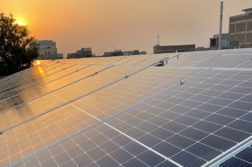Kevin Rudd’s announced changes to the proposed Carbon Pollution Reduction Scheme has again split the climate movement, and this time it’s very serious, with three large, rusted-onto-Labor groups providing cover for an appalling policy that won’t guarantee a reduction in Australia’s emissions for decades.
The grassroots movement, which gathered in Canberra in January with 500 people and 150 groups for the first national Climate Action Summit and unanimously opposed the CPRS legislation, appears uniformly angry. The Prime Minister has received 66 letters from climate action groups saying they "believe that you have abandoned your duty of care to protect the Australian people as well as our species and habitats from dangerous climate change".
The re-worked proposals for the Carbon Pollution Reduction Scheme announced yesterday were described by the Greens as "making the ‘worse than useless’ scheme even worse and giving another $2.2 billion to big polluters. It also fails on voluntary action" and has an "almost irrelevant green distraction of a hypothetical 25 per cent target to undermine criticism".
John Hepburn of Greenpeace said: "It’s clear that Rudd has been listening to the big polluters and this is another shift towards the interests of polluters rather than climate action. We’re rapidly running out of time and we’d like this scheme to go back to the drawing board until Kevin Rudd can stand up to the big polluters and take action in the interests of the Australian people."
Friends of the Earth "criticised the raising of the government’s hypothetical target range as an exercise in ‘smoke and mirrors’, aimed at hiding the further windfall for polluters".
But the three climate advocacy groups that have acquiesced or actively supported the Government’s "clean coal" policies — ACF, the WWF and Climate Institute — again lined up to support Labor, together with the ACTU and ACOSS. Michelle Grattan in The Age noted that "the biggest concessions are the brown ones" and said that "Kevin Rudd has stitched key groups in behind a revised emissions trading deal — both browner and greener than before — to put maximum pressure on Malcolm Turnbull."
John Conner of the Climate Institute on behalf of the Southern Cross Climate Coalition (ACF, ACTU, ACOSS and Climate Institute) said it was now time for all parties to pass the scheme.
Australian Conservation Foundation CEO Don Henry told staff: "We have achieved a significant step forward on climate change. The Government has just announced that it will take on a target of reducing Australia’s emissions by 25 per cent by 2020 in the context of a Copenhagen agreement that has the effect of stabilising emissions at 450ppm or lower." (That is itself untrue, of which more later.) ACF climate campaigner Owen Pascoe added: "This is a good step forward and the positives outweigh the negatives. However there’s a lot more to be done and we’ll keep pushing for our ask of 30 to 40 per cent cuts."
Just so we know what we’re talking about, let’s take a minute to look at exactly what the new changes Rudd has announced would mean.
Rudd’s now planning to delay the scheme’s introduction for a year to 1 July 2011 and set a nominal carbon price of $10 a tonne with an unlimited number of permits until 1 July 2012, so there will be NO effective action for another three years.
He’s also going to increase the permits to the biggest polluters in the first year from 90 per cent to 95 per cent for the most assisted group and from 60 per cent to 70 per cent — so that in the first year the biggest polluters will be effectively paying 50 cents per tonne to pollute, as Environment Victoria noted.
The changes will keep the provision for unlimited outsourcing of Australia’s national responsibilities by allowing the purchase of permits from overseas without limit, so that the scheme has no mechanism for ensuring that Australia’s emissions (as opposed to domestic permits) will drop by even one tonne by 2050.
The scheme still fails to deal adequately with the question of additionality and voluntary action. As Environment Victoria notes: "The fix to recognise household and business voluntary action through GreenPower is welcome, but the mechanism is awful. By only recognising additional GreenPower purchases above 2009 levels the Government is guaranteeing the collapse of existing GreenPower customer purchases and therefore jeopardising the whole program."
At the same time, the scheme will not (contrary to back-slapping comments by the ACTU) produce an avalanche of "green jobs" because it is not designed to close down the brown jobs. Instead of building a clean, renewable-energy economy and technological capacity, Australia will continue to stumble at the back of the pack.
So why are some of the big climate advocacy groups so keen on this disaster? (Or rather, why are they expressing public support for a scheme which is massively at odds with some of their private positions?) And is their public position actually supported by the evidence? To get a better sense of what’s going on, here’s a look at the views expressed by ACF and others, and whether they’re justifiable.
View 1: "Passing the CPRS is necessary for Australia to be credible at Copenhagen."
No, quite the opposite. If there were no legislation, Australia’s position would not be tied by law to Rudd’s poor target and pressure would be maintained to catch up with the leading bunch. The targets in the proposed CPRS legislation are out of whack with the major players such as the UK, US and EU, who have agreed to unconditional emissions cuts of 34–46 per cent, 20 per cent and 20–30 per cent from 1990 levels respectively. Let’s be honest: what happens at Copenhagen depends more than any other factor on what the "G2" — the USA and China — strike by way of a climate deal, and what Australia puts on the table has little relevance to that. They are used to Australia behaving badly.
View 2: "If there is a reasonable outcome in Copenhagen, Australia will be committed to a 25 per cent cut by 2020."
As Adam Morton reported in The Age today, despite "yesterday’s spin about progress in international climate talks", Rudd and Wong are certain that whatever deal is done in Copenhagen it won’t be enough to force a 25 per cent emissions cut by Australia under the terms they have set.
View 3: "The CPRS can reduce Australia’s emissions by 25 per cent by 2020."
This is complete bull, regardless of what happens at Copenhagen. By allowing an unlimited number of permits to be bought from overseas, through such dubious schemes as REDD and the CDM, the CPRS cannot guarantee that even one tonne of Australian emissions (as opposed to domestic permits) will be cut. The Treasury modelling assumes no drop in Australian emissions for another 25 years.
This provision alone should be enough to scuttle the whole scheme. How can this be "a significant step forward on climate change" as Rudd’s supporters in the environment movement claim publicly when it won’t guarantee to cut any domestic emissions at all? In fact, what the CPRS is doing is trying to lock in through legislation, for decades to come, a high-pollution economy dominated by high-pollution industries and brown jobs.
View 4: "If the high-polluting nations such as Australia adopted a policy of reducing emissions to 25 per cent below 1990 by 2020 this would likely lead to an international agreement that would stabilise emissions at 450ppm or lower."
This idea is a case of "if you say something often enough, you’ll end up believing it". Too many climate groups and climate scientists have been saying this so long and so often, yet it is so untrue.
The 2007 IPCC report found that Australia (and all the other Kyoto Annex I countries) would need to reduce emissions by 25–40 per cent by 2020 for a 450ppm target. Note how everybody has dropped the 40 per cent end of this formulation, as if it never existed. Australia, as the highest per capita polluter of the Annex 1 members, would certainly be at the 40 per cent end of the range, but this is rarely mentioned.
View 5: "Stabilising at 450ppm would reasonably limit global warming to 2˚C."
No it won’t. Analysis for the 2006 Stern Report (p. 195) shows that a 450ppm CO2e target has a 26–78 per cent probability of exceeding 2˚C relative to pre-industrial levels, but also a 4–50 per cent probability of exceeding 3˚C!
That is not defensible and I can’t understand how anybody who works professionally on climate change could think for one second that it is a reasonable target to utter in public.
After a careful reassessment of climate sensitivity and climate history data, NASA climate science chief James Hansen and his colleagues concluded that the tipping point at which substantial ice-sheets on Earth will disappear is around 450ppm (+/-100 ppm) of CO2. This means that the CO2 levels often associated with a 2˚C rise — 450ppm — may just be the tipping point for the total loss of all ice sheets on the planet and a huge sea-level rise.
If you are silly enough to contemplate a 2˚C rise, then just to have a 66 per cent chance of limiting warming at that point, atmospheric carbon needs to be held to 400ppm CO2e and that requires a global reduction in emissions of 80 per cent by 2050 (on 1990 levels) and negative emissions after 2070. And with high climate sensitivity, a risk-averse target for 2˚C is around 350ppm CO2e — and all this is necessary just to meet a 2˚C target that is actually dangerous.
The big groups know privately that 350ppm and lower should be the target. John Connor of the Climate Institute wrote recently that the science leads us to 350ppm, and ACF Council has adopted a 350 ppm target, but this has not yet seen the light of day in ACF’s public advocacy.
View 6: "2˚C is a reasonable target to avoid dangerous climate change."
No, it will ensure that climate change IS dangerous. A rise of 2˚C over pre-industrial temperatures will initiate large climate feedbacks in the oceans, on ice-sheets, and on the tundra, taking the Earth well past significant tipping points. Likely impacts include large-scale disintegration of the Greenland and West Antarctic ice-sheet; the extinction of an estimated 15–40 per cent of plant and animal species; dangerous ocean acidification; increasing methane release; substantial soil and ocean carbon-cycle feedbacks; and widespread drought and desertification in Africa, Australia, Mediterranean Europe, and the western USA.
The loss of the Greenland ice sheet produces about a 7 metre global sea-level rise. One conclusion is that advocacy of the 25–40/2020 target, for example by the ACF in its 2008 "Special Places" campaign, will result in the destruction of many of the "special places" in Australia that the ACF wants to protect; Kakadu, for example, will salinate with a sea-level rise of less than 1 metre.
Hansen told the US Congress in testimony last year that: "We have reached a point of planetary emergency … climate is nearing dangerous tipping points. Elements of a perfect storm, a global cataclysm, are assembled … the oft-stated goal to keep global warming less than 2˚C is a recipe for global disaster, not salvation." But the ACF says the Government announcement of "a target of reducing Australia’s emissions by 25 per cent by 2020 in the context of a Copenhagen agreement that has the effect of stabilising emissions at 450ppm or lower" is a "significant step forward on climate change".
Take your pick, but I’d rather go with the climate scientist . As Ken Ward, the former deputy director of Greenpeace USA and an environmental strategist has so acutely observed, we must "stop seeking and celebrating dinky achievements" because "nothing that we are doing, nor even seriously contemplating, comes anywhere near such a massive transformation [as is necessary], yet every actor on the political stage … downplays the terrible realities and trumpets small-scale solutions wrapped in upbeat rhetoric … We are racing toward the end of the world and have no plan of escape, but it is considered impolite to acknowledge that fact in public."
View 7: "If this legislation is passed, it is reasonable to expect that the Government will do more and go further than its own legislation."
Pull the other leg.
It appears the strategy of the groups who have endorsed the CPRS is to pretend that we don’t face a climate crisis that requires emergency action, so they endorse incremental policies and never talk about the elephant in the room. That elephant is this: we only get one shot at this, and we don’t have the luxury of a trial option that locks in a bad policy for decades.
Today with global warming at just less than 1˚C we are witnessing the destruction of the Arctic ecosystem. Eight million square kilometres of sea ice is disappearing each summer and may be entirely gone within a few years. Already 80 per cent by volume of summer sea-ice has been lost, and regional warming of up to 5˚C may have already pushed the Greenland ice-sheet past its tipping point.
But are the ACF, the Climate Institute and the WWF telling the Government this?
We know that the present level of greenhouse gases is enough to increase temperatures by more than 2˚C over time. We have already gone too far, there is already too much carbon in the air. At less than 1˚C we are on the way to triggering a multi-metre sea-level rise that will devastate coastal infrastructure, delta peasant-farming communities and some of the world’s biggest cities. Our only choice is to head back to 0˚C of warming, to halt all emissions and reduce atmospheric carbon to return the planet to a safe-climate zone.
Hans Joachim Schellnhuber, director of the Potsdam Institute and Europe’s leading climate scientist, says that "we are on our way to a destabilisation of the world climate that has advanced much further than most people or their governments realise", so "our survival would very much depend on how well we were able to draw down carbon dioxide to 280 parts per million", compared to the present level of close to 390ppm.
And are the ACF, the Climate Institute and the WWF telling the Government this?
Put starkly, we either keep warming within the limits at which carbon feedbacks become sufficiently pervasive as to make further human action futile, or we don’t. We have a safe climate or we have a global catastrophe. There are no middle-of-the-road compromises. We must head back towards zero. At 1˚C the genie is out of the bottle, at 2˚C the bottle is broken.
One of the great powers of the climate action movement is our capacity to withhold support from — and actively campaign against — government actions that are designed to fail, as the CPRS will. Presently there is political denial, even an arrogance of power that leads governments to believe that they can negotiate with the climate and the laws of physics and chemistry. We’re living in a land of tradeoffs, where climate is just another issue, the politics are partisan, the action slow, and it’s all embedded in a culture of compromise and failure. Monday 4 May was a great example.
And it is a tragedy that some people who should know better are warmly praising such a failure.
Donate To New Matilda
New Matilda is a small, independent media outlet. We survive through reader contributions, and never losing a lawsuit. If you got something from this article, giving something back helps us to continue speaking truth to power. Every little bit counts.



